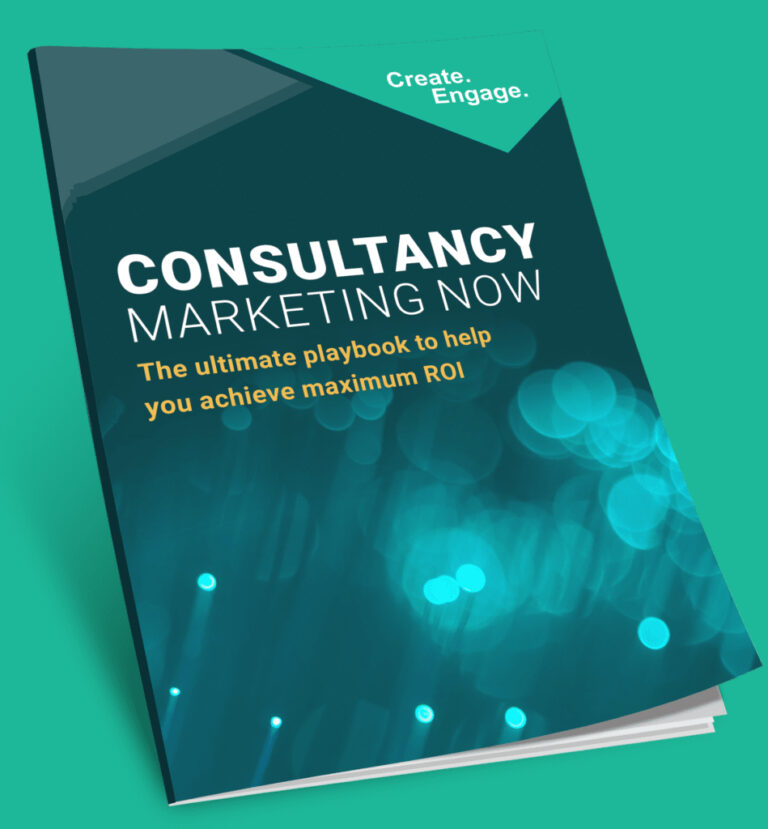When someone lands on your site, you only have a matter of seconds to grab that person’s interest and draw them into your page. If you don’t do that, they’ll move on quickly.
The problem for many Consulting firms is that they fail to do this and are left wondering why their bounce rate is so high. There could be a number of reasons but one of the biggest is because most Consulting firms’ websites aren’t very engaging!
The typical Consulting website
We tend to find Consulting firms’ websites fall at one of two extremes.
The majority have basic brochure sites with the bare minimum information. They have a Home page, an About Us page, a Contact page, and maybe one or two other pages showcasing the type of work they do, and a company blog. While this is fine if you’re just starting out, it’s not going to cut as you begin to grow.
On the other end of the spectrum, there are firms that believe because they’re established they should do the complete opposite. They overwhelm visitors to their site with a deluge of menus, sub-menus, links and pages – but once you dive in, you realise that many of these pages don’t actually tell you much about the firm.
Too simple, or too complex: the ultimate end result is the same. A lack of engagement and a lack of value provided to your visitors. Thousands of pounds spent on producing a website with no discernible ROI.
Thankfully, there is a way forward. With some focused thinking and an understanding of best practice, you can turn your website from a hygiene factor into a real competitive advantage.
Start with why
As we’ve mentioned a number of times, the first crucial step is to start with why. Why do you have a website in the first place? What is the point of your firm’s website, and what message are you trying to convey?
It’s entirely possible you’ve never actually asked these questions before. You might just have a website because that’s what proper, respectable companies do.
If you ask yourself these questions, your first answer is likely to be something along the lines of, “Well, we have a website so that our firm appears reputable and legitimate – not having a website is seen as weird.”
That’s true. At a minimum, you do need to have a website, to show that your firm actually exists.
Now go one level deeper. Why is that important? It’s important because it helps to build social proof and build credibility and trust among your potential clients. It makes them more likely to buy from you.
So, the point of your website is to build credibility and trust in your firm.
If you agree with this view then the answer to “why do we have a website?” is to build sufficient credibility and trust in your firm to help you turn potential clients and recruits into actual clients and recruits.
Having a website that looks just like everyone else’s is an ineffective way to do that. Instead, you should be using your website to showcase your firm’s brand, expertise and differentiation.
As an aside, it’s also worth pointing out that the goal of your website often isn’t to tell your visitors more about your firm and what you do. It’s incredibly rare that you’ll get search traffic from people googling phrases like “finance transformation consulting firm” or “best consultants for target operating model”. Optimising for search engine traffic works for e-commerce businesses, but for Consulting firms, your visitors will almost certainly have heard of you before visiting your site.
Focus on your homepage
A picture speaks a thousand words, so let’s show you a bad example and a good example. In fact, these examples both come from the same firm, Elixirr.
Firstly, this is Elixirr’s old website, circa 2012:
There are a number of issues with this, but the main one is that the homepage tells you nothing about the firm itself, or why you should work with them. They do put forward a few cliched points for how they’re different – inspiring comment and research, relevant smart solutions, real client case studies – but almost any other Consulting firm could claim these too. It also has the generic page list of Home, About Us, Services, Careers, etc. etc.
From the point of view of a potential client, this website is not engaging, tells them nothing about why they should work specifically with Elixirr, and doesn’t provide any call to action to keep them engaged.
Now, let’s contrast that with Elixirr’s new homepage (live as of 17th January 2019):
Firstly, notice how much cleaner this page is. Your homepage – and in particular the top of your homepage – will be the most visited page on your site. Unfortunately, studies have shown that 55% of visitors to a webpage will spend less than 15 seconds on that page, and 80% of visitors won’t make it to the bottom of the page. So it’s crucial that you make a good first impression on your target client with a bold homepage. Elixirr does just that with this minimalist homepage. In fact, the only things on the page are:
-
The name of the firm
-
Their tagline, The challenger consultancy, which instantly communicates their branding and positioning
-
The subtitle, Give us your toughest business challenge, which adds context to the tagline and acts as a call to action
-
An arrow asking you to click to read more
Seeing this as a potential client, it’s hard to be confused about what Elixirr is all about. At the very least, you’ll need to click the down arrow and engage with the site to find out if they operate in your particular niche.
Elixirr then does a good job of walking the visitor through the website in the way that they want them to read it. Each new section of their homepage taking up one screen in total, so the reader’s attention is focused on that one thing. The reader then has the option to either read further down the page, or click that item to see more detail.
Again, given the limited time and attention of your audience, this is an excellent way of shepherding them through your site to ensure they stay engaged.
If you have limited time and money to spend on your website, you should focus on making your homepage as good as possible. In fact, even if you have a lot of time and money to spend on your website, start by making your homepage great and then go from there.
Showcase your expertise
Once you’ve grabbed people’s attention, you need to use that time to quickly showcase your firm’s experience and demonstrate social proof – How you’ve helped others achieve the same thing as your prospective client is looking for.
The Berkeley Partnership are a great example of how to do this effectively. Right their on their homepage, they have a large, focused, section that asks prospective clients to find out why other clients think they’re great. Instead of listing the standard set of Consulting cliches about why a client should work with them – a la Elixirr 2012 – they confidently say “Our Clients Say It Best”.
This is a hugely powerful statement and talks directly to prospective buyers who are looking for exactly that. Social proof from other clients to reassure them that Berkeley are the best firm to work with.
Click on this and you’re taken to Berkeley’s client page where the first thing you are presented with is a range of high quality and engaging client testimonial videos from C-level clients.
These really help Berkeley stand out from the crowd by implicitly saying “if the CEO of our previous client is willing to take a day out of their busy schedule to record this video for us, just think how happy they must have been with our work!”.
As well as this, video typically gets much higher engagement rates than standard text or images. Recent stats show that 59% of executives agree that if both text and video are available on the same topic, they are more likely to choose video.
This approach of putting your social proof upfront and showcasing it via video is incredibly effective, and really highlights Berkeley’s credibility. It’s a tool that barely any Consulting firms are using currently but one with massive potential when used effectively.
Recap
We already know that most Consulting firms’ websites just aren’t that engaging. Thankfully, this means that it’s much easier for those who put some focused effort into theirs to stand out from the crowd.
The websites from the firms we’ve shown, Elixirr and the Berkeley Partnership, aren’t particularly complex, fancy or dynamic. They’re simple, clear, easy to navigate and convey credibility and social proof.
It’s as simple as that. Do the basics brilliantly. Give your reader what they need, in a way that’s easy for them to digest, that showcases your firm’s expertise and experience in a way that captures your prospective clients.
That’s all it takes to turn prospective clients into actual clients.
Key takeaways
-
Understand why you have a website. The point of your website is to build credibility and trust in your firm, in order to turn visitors into clients (or recruits)
-
Give your readers enough information to interest them, but not so much that you overwhelm them.
-
Make the content simple and easy to navigate, in a way that makes sense to the reader.
-
Showcase your expertise and clients in order to build credibility and social proof.
-
If you can find ways to effectively use video, do it!
If you want to develop a Digital Marketing strategy that drives results for your Consulting firm, feel free to get in touch – we’d love to talk to you!



